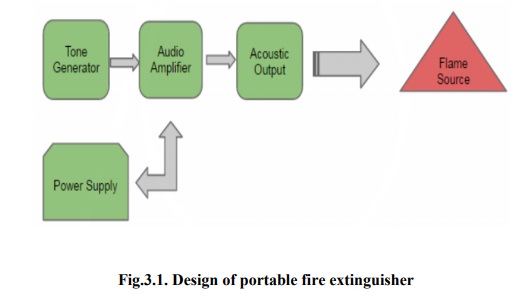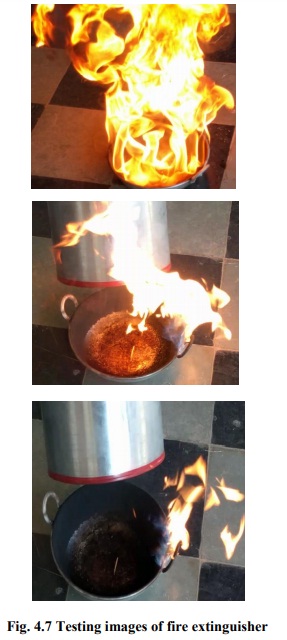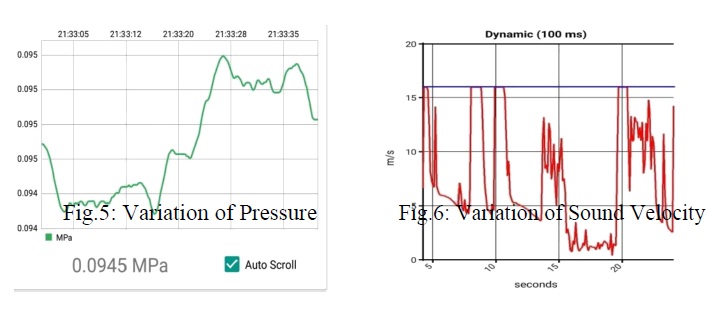





Published on Nov 30, 2023
The need of fire extinguishing techniques is vital as fire accidents are catastrophic in nature, leads to unrecoverable loss. The current fire extinguishing comes with various drawbacks. The present existing techniques are not eco-friendly. The need for new fire extinguishing techniques is vital as fire accidents cause deaths and injuries. Sound wave could be one of the potential alternatives as fire extinguishers. The low frequency acoustic waves spilled from a speaker tend to extinguish the flames. The present research aims to develop the potable fire extinguisher study and analyzes the effect of different frequency of sound wave on flames. Experiments are conducted to study suitable sound wave frequency range to extinguish flame and to analyze the acoustic-flame interaction through observations using portable and innovative approach to reduce the overall cost. Further the research is carried out to study the critical parameter such the length to diameter ratio of the vortex tube on velocity, Pressure of waves are discussed. Mobile sensors are used to record the data.
The combination of varying high and low pressure and coupled with high flow air velocity, which in then causes disturbances in air-fuel ratio at the flame boundary (leading to thinning of flame boundary), is one of the possible explanation leading to flame extinction.
Fire is a self-sustaining, chemical chain reaction with varying degrees of light and heat. Flame is the observable portion of the fire. Fires start when a flammable and/or a combustible material, in combination with an adequate quantity of an oxidizer for instance, oxygen gas is exposed to a source of heat or ambient temperature above the flash stage for the fuel/oxidizer mix, and is able to withstand a rate of rapid oxidation that produces a chain reaction. Fire is made up of four components •Fuel, Oxygen Heat and Chemical Chain Reaction. This is normally called the fire tetrahedron.
Fire cannot exist if deprived of all of these elements in place and in the right proportions.Fire extinguishers are divided into four categories, based on different types of fires. Each fire extinguisher also has a numerical rating that serves as a guide for the amount of fire the extinguisher can handle. The higher the number, the more fire-fighting power. The following is a quick guide to help choose the right type of extinguisher. Also see how to buy a fire extinguisher. Class A fires are fires in ordinary combustibles such as wood, paper, cloth, trash, and plastics. Class B fires are fires in flammable liquids such as gasoline, petroleum oil, and paint. Also included are flammable gases such as propane and butane. Class B fires do not include fires involving cooking oils and grease. Class C fires are fires involving energized electrical equipment such as motors, transformers, and appliances. Remove the power and the Class C fire becomes one of the other classes of fire. Class D fires are fires in combustible metals such as potassium, sodium, aluminum and magnesium.
Our objective is to develop an environmentally friendly and safe method to extinguish fire using acoustics set up.
1. To identify the frequency range that will be able to suppress an open flame.
2. To identify an optimal range of frequencies in which to achieve the minimum sound energy when extinguishing fire.
3. To identify the frequency range that will be able to suppress an open flame.
4. To analyze the physics of sound-flame interactions
Sound is mechanical wave. The development of a portable fire extinguisher is initiated with the basic design approach shown in fig. The key components includes a tone generator, generates the audio signal. The tone generator is interfaced with the subwoofer, which converts the low frequency waves into sound waves these waves are amplified using amplifier. The generated sound waves are made to travel to the vortex tube. Subwoofer along with the vortex cannon is designed to produce extremely low frequencies is used to manipulate the sound waves. The waves are further tuned in a frequency generator until they extinguish the fire.

The methodology of developing a portable fire extinguishers system is shown in fig. The critical equipment essential for the development of the potable fire extinguisher is identified and purchased. . The experimental setup is developed for investigate the optimum critical frequency followed with data analysis and report documentation.

A tone generator, also known as a signal generator, described as electronic audio acoustics and equipment testing and setup, or informational signals, commonly associated with a telephone system. In each case, electrically generated audio pulses are sent to specific components. In the case of audio equipment testing, frequency response and sound evaluation are noted, and the acoustic properties of a studio or hall may be determined. With a telephone system, the dial tone, busy signal, and ring tone are the result of this pulsed tone generation.

These devices will not only generate a tone, but may also be used to replicate certain electronically produced or recorded audio signals. The results of the signals are described variously as white noise or pink noise, depending on the energy level of the sound pulse. The sound pulses may be seen on an oscilloscope as sine waves, a sound-wave pattern generated at 20 hertz (Hz) to 20 kilohertz (kHz), and the basic range of audio frequency. The variations in the highs and lows of the sine wave, as well as the distance between them, determine the effectiveness of audio equipment, both in receiving and producing certain sounds along predetermined points within the audio frequency range. Other representations of tone pulsations and frequency generation include a saw tooth wave, a triangle wave, a square wave, and various others. These particular representations indicate loudness, harmonics, and/or decreasing or increasing energy levels of the audio impulses. These impulses, of a specific tonal quality and energy, may be visually interpreted on the oscilloscope through the depiction of a particular pattern. One pattern that combines harmonics and pulse energy will resemble a series of triangles, another will give a saw tooth pattern, another squares, and so on.

We believe that the primary acoustic mechanism of suppression of gaseous fuels is, in part, a blow-off mechanism; where the acoustic wave imparts kinetic energy to the reactants of the flame causing the net velocity of reactants to be greater than the flame propagation velocity.In Figure flame oscillates about the fuel under acoustic excitation. The flame detaches from the bowl fire prior to extinction after approximately 1.7s.Initially, the total flame underwent oscillations about the source. Shortly after acoustic excitation, the flame lifted off of the burner but did not extinguish. The flame appeared to undergo chaotic mixing in the lifted state as it oscillated within the acoustic field; this mixed state represented induced changes in the gradient between fuel and oxidizer. Eventually, the acoustic perturbation extinguished the flame in its lifted state. Since the flame existed in the lifted state, we can conclude that the present mechanism works efficiently to extinguish the flame.

Sound wave significantly effects on the fire extinguishers process. To evaluate the impact of sound waves on the fire, the fire was exposed varied frequency of sound waves from 0 Hz, 10 Hz, 30 Hz, 35 Hz, and 40Hz.

The Sound travels in waves, which are simply variations of pressure in a medium. The energy from vibrating objects, such as speaker membranes, moves from particle to particle in the air in a repeating pattern of high- and low-pressure zones that is perceived as sound. It is found that the effective range was between 30 and 40 hertz, within the range of human hearing.
No residue compared to chemical fire Extinguisher.
Lighter material weight
Less damage to surroundings
Nontoxic
No expiration date
No refilling date
The Instant Fire Suppression device specifically uses new ways of tackling fires in enclosed spaces, such as Aircraft cockpits and ship holds, Kitchen, hospitals and shopping malls, Industry, and railways where fires are obviously devastating and incredibly difficult to control. It is used in small fires and can be used in home caused fires. Generally when fire is caused in an electrical panel circuit, using water is not possible as water conducts electricity, thus using sound waves to extinguish fire is one of its main application. It can be used in place of chemical fire extinguishers and water as sound wave fire extinguisher leaves no residue and it is nontoxic to the person and the environment
The idea of extinguishing fire with sound is a novel one, and has many possible applications in today’s world. With knowledge of the resonant behavior of a room or enclosure, the present research aids in incorporating a single (or multiple) speaker within it to achieve acoustic velocities in specific areas of interest. One can generate a specific air velocity using various combinations of pressure and frequency. This technique of suppression would require knowledge of the geometry of the acoustic cavity, so that the optimum placement of the speaker(s) can be achieved, as well as excitation with optimal the resonant frequencies for the room. The present research addresses the fire in a room by localized mobilization of instruments. This is done effectively by coupling the mobile to the resonant modes of an acoustic cavity, to extinguish flames at-a-distance or at specified locations such as anti-nodes within a room. In order to extinguish large area flames acoustically using the current setup, either a larger or more powerful (higher SPL output) speaker would need to be used. Directly increasing the output power of a speaker, will cause signal clipping; a distortion of the output signal. One can multiplex speakers to achieve extinction of larger flames, however the practically of such a system comes into question. Hence there is need of further research investigation to attempt for large fire extinguishers.
1. Report Flame Suppression Acoustic Suppression. (n.d.). Office of the Secretary of Defense and Joint Staff FOIA Requester Service Center -Defense Advanced Research Projects Agency (DARPA). Retrieved September26, 2014, fromhttp://www.dod.mil/pubs/foi/Science_and_Technology/DARPA/
2. Fire. (n. d.). Wikipedia. Retrieved October 5, 2014, from http://en.wikipedia.org/wiki/Fi
3. Sound. (n. d.). Wikipedia. Retrieved October 5, 2014, fromhttp://en.wikipedia.org/wiki/Sound
4. Fire Safety, Part 1: About Fires and Fire Types. (n.d.). About Fires, Part 1. Retrieved October 16, 2014, fromhttp://chemlabs.uoregon.edu/Safety/FIre1.